Hang power clean кроссфит: CrossFit | The Hang Power Clean
Are They Any Different? – Torokhtiy Weightlifting
As far as building power goes, there are few exercises as effective as the clean. The hang clean and power clean are two variations of this incredible weightlifting workout. So are they any different? What’s the difference between them? Who wins the hang clean vs power clean matchup? We’ll find out in today’s article.
First, the short answer.
Short answer
Yes, they’re different. Hang clean vs power cleancomparison is less straightforward. If your target is your explosion and squat routine, hang cleans are best. If you’re after speed and mastering transitions, pick power cleans.
Now for the long answer, we must first understand each variation. First, the hang clean.
What Is A Hang Clean?
A full clean is a part of the Olympic clean and jerk exercise. To do a clean, you must pick a barbell from the floor and bring to your shoulders in a single, fluid motion.
There are some variations of the clean movement. One of these versions of the clean is called the hang clean.
A hang clean is a variation of the full clean workout that basically skips the first (starting) position and first pull. The move starts with the barbell already above the knees instead of on the ground. You go straight to the second pull and catch.
The hang clean targets muscles all over your body. Biceps, triceps, and muscles in your shoulders and forearm are all heavily engaged. It also targets your lower back, hamstring, glutes, and hip muscles.
Sounds impressive, but the hang clean vs power clean matchup is far from over.
Pros and Cons of the Hang Clean
Pros
- It’s a full body workout that engages several important muscles.
- It helps you improve your weightlifting technique.
- It improves your explosive power.
- It’s easier to learn and perform than a full clean.

Cons
- Because it bypasses the first position and pull, it’s not enough to fully prepare you for a full clean and jerk.
How to Do a Hang Clean
The hang clean consists of different stages of movement.
- The starting position for a hang clean has the barbell above your knees, somewhere mid-thigh. Keep your gaze forward and your knees straight.
- In one fluid motion, aggressively extend knees to generate momentum and pull the barbell up. At the same time, bend to a squat position so that you can slide in underneath the barbell. This move is called the second pull or the explosion.
- Once you slide in underneath the barbell, catch it on your shoulders, just above your chest. This position is known as the catch position.
- Stabilize yourself, then stand up straight with the barbell still resting on your shoulders.
- Return the barbell to the starting position just above your knees or mid-thigh.

- Go again!
You can see the hang clean in practice to get the full picture.
Mistakes to Avoid in a Hang Clean
Form and technique are everything in the hang clean. Getting either one wrong can result in fruitless movements at best or injury at worst. Here are a few common mistakes you should take care to avoid.
1. Wrong setup, especially in the starting position, can make life difficult for you.
- Overextending the bar before the explosion is one common example.
- Rounding back in thoracic spine instead of keeping your back straight can also lead to extra stress or injury.
2. Using your hands to do the pull is a risky move that could injure you.
Instead, use the triple extension. It involves a simultaneous extension of your ankles, knees, and hips.
What is a Power Clean?
Like the hang clean, a power clean is a variation of the full clean. Unlike the hang clean, a power clean starts with the barbell on the floor.
Power cleans follow the same basic movement of a full clean. Pick the barbell from the floor, pull to your mid-thigh, then explode upwards and squat to catch it on your shoulders. There is only one difference: the squat depth when catching the barbell.
The power clean doesn’t require a full squat like the full clean. This means less movement, and makes power cleans easier to master.
The power clean is so popular because it’s essentially a full body workout. It works on the muscles in your shoulder, back, and stomach. It also targets muscles in your legs. Your calves, glutes, hamstring, and quads are all heavily engaged.
Pros and Cons of Power Clean
Pros
- It’s easier to master than the full clean.

- It’s a full body workout that works on muscles all over your body.
- It improves your explosive strength.
- It helps you master the first part of the full clean technique.
Cons
- It doesn’t let you lift weights as heavy as the full clean does.
How to do a Power Clean
A power clean involves essentially the same steps as a full clean.
- The starting position has the barbell on the ground. Stand with your feet underneath the barbell and split about as wide as your shoulder. Then squat down to grab the bar with your hands just outside your feet. Make sure to keep your back straight.
- Pull the barbell up as you stand slowly. Continue lifting until you are standing upright and the barbell is around your mid-thigh area. This is called the first pull.
- Aggressively extend knees, and explode upwards with the barbell in one fluid move. This is called the second pull or explosion.

- As you lift the barbell, slide your body underneath it by dropping into a quarter squat position. Your elbows will snap forward and underneath the barbell as you pull.
- Then you must catch the barbell neatly on your shoulders, just above your chest. Stabilize yourself and stand up straight while holding the barbell.
- Lower the barbell and release it back to its starting position.
- Go again!
Watch the power clean in action to get the full picture.
Mistakes to Avoid in a Power Clean
Form and technique are central to completing any workout, and the power clean is no different. Mistakes can often result in fruitless movements or injuries. Here are some common ones you should avoid:
1.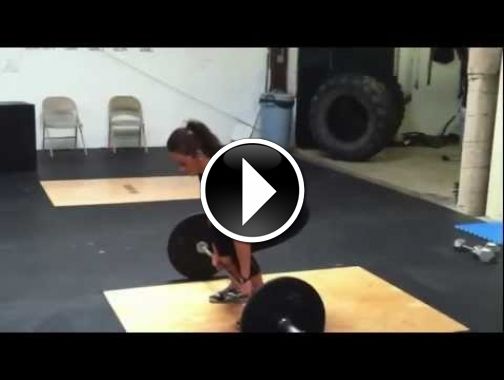 Wrong posture can expose the wrong muscles and lead to strain or injury.
Wrong posture can expose the wrong muscles and lead to strain or injury.
- Curving your back when squatting to make the first pull is a common mistake that could cause damage.
- Overextending your legs is another common error.
2. Wrong movement during execution can also be dangerous.
- Catching the barbell with your hands instead of on your shoulders is a common one. Check that by making sure your elbows are facing outwards, not downwards.
Hang Clean vs Power Clean: Head to Head
Now that we’ve settled the difference between hang clean and power clean, the next question is: which one is better for you?
To tackle this question, let’s look at a head to head comparison in some key areas.
Complexity and Difficulty
Both hang clean and power clean are easier versions of the full clean. Among them, power cleans usually involve lesser weights, but involve the same movements as the full clean.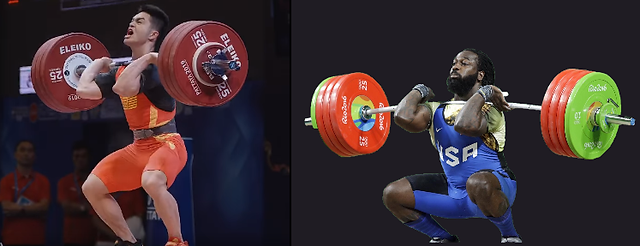
The hang clean provides a less complex set of movements by skipping the first pull, but involves heavier weights and a full squat.
Which one you find easier will depend entirely on you.
Explosive Strength
Both hang clean and power clean involve the second pull. Both workouts will help you develop explosive strength and faster movements.
Where the power clean slightly edges the hang clean is that it involves the full transition from first pull to second pull. This slight difference helps you power through different positions more easily.
Force Development
The power clean helps you generate force through the whole clean process. You learn to start from the floor and move upwards generating force as you go.
The hang clean does it a bit differently. By skipping the first pull, the hang clean eliminates the use of momentum in generating force to focus on hip drive. This makes for more explosive movements.
Timing of the Clean
Because the clean involves multiple different movements, it’s important to nail the timing of each move.
A power clean will help improve your timing much better because it covers the whole movement process, as opposed to the hang clean that skips the first pull.
Transition to Full Cleans
The major point of both hang clean and power clean is to train for the full clean. The hang clean helps you master the second pull and catch phases of the clean, while the power clean helps you master the transition from first pull to explosion.
So it depends on what part of your clean movement needs the most work. Both workouts can be very helpful.
Questions You May Have
Which one is easier: power clean or hang clean?
The power clean involves the entire process of the full clean while the hang clean skips the first pull. This gives the impression that the hang clean is easier, but that’s not always the case.
The hang clean involves heavier weights and a full squat. By skipping the first pull, it also eliminates any momentum that you may have generated.
Like most things in fitness, there’s no clear answer.
Do hang cleans make you faster?
The hang clean focuses on developing explosive power. This power will make you stronger and faster. It will improve not just your speed, but your acceleration.
Are hang cleans better than power cleans?
Yet again, there is no clear answer to this. Much of it will depend on what your goals are. Hang cleans will help you lift heavier weights, master the explosion, and nail the squat.
Power cleans will help you improve explosive movement through various positions. They’ll help you nail your transitions and move faster.
Are hang cleans good for football players?
Yes. Hang cleans help you become more explosive and athletic. This will only help if you’re a football player.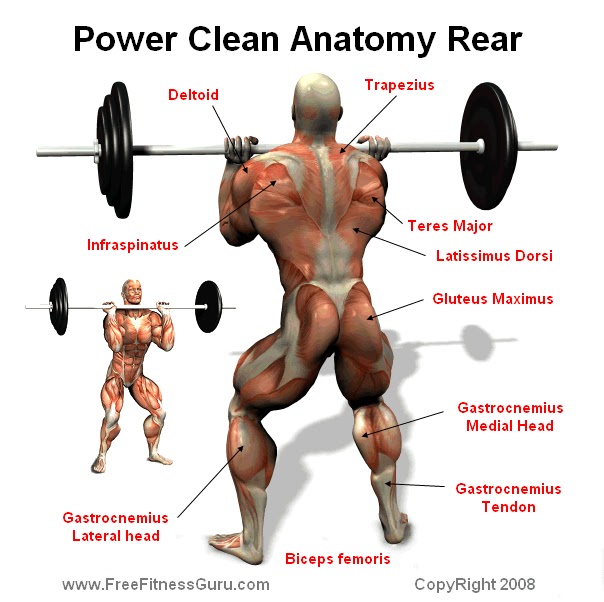 That said, some will argue that power cleans are better in this regard because they focus more on speed and involve less weight.
That said, some will argue that power cleans are better in this regard because they focus more on speed and involve less weight.
Others will argue that there are better workouts to do for football players such as jumps, throws, and plyometrics.
Are power cleans good for vertical jump?
Yes. Power cleans are all about generating explosive power from the ground right up in one fluid motion. That kind of power means you can run faster and jump higher.
Conclusion
The power clean vs hang clean comparison is a close one. Both are both incredible workouts that will help you get stronger and faster. If you want to lift heavier weights and focus on the explosion and squat, go for the hang clean. If you’d rather work on maximizing speed and mastering transitions, the power clean is your drug.
Now it’s your turn! Which version of the full clean is more attractive to you? Why will you pick one over the other? Have I missed anything? Tell me all of it in the comments!
You might be interested in:
core and back workout program
overhead mobility program
masters olympic weightlifting program
8 week weightlifting program
bodybuilding lifting program
power clean emom
название упражнений в кроссфите на русском и английском – Cross World
- 19 февраля, 2018
- Ольга Распопова
Не секрет, что англоязычные сайты часто предлагают больше информации о кроссфите, чем отечественные. Эта шпаргалка позволит вам использовать зарубежные агрегаторы тренировок и использовать программы на английском.
Эта шпаргалка позволит вам использовать зарубежные агрегаторы тренировок и использовать программы на английском.
Упражнения со штангой
Back Squat – приседания со штангой на спине
Bench press – жим лежа
Clean – подъем на грудь
Clean & Jerk – толчок
Cluster – кластер. Это сложное упражнение, объединяющее взятие на грудь с пола и трастер
Deadlift – становая тяга
Hang squat clean – подъем на грудь с виса
Front Squat – приседания со штангой на груди
Good morning – “гудмонинги” или наклоны со штангой на спине
Hang power clean – силовой подъем штанги с виса
Hang power snatch – рывок с виса
Hang squat clean – подъем на грудь в сед с виса
Jerk – толчок в ножницы
Overhead squat – Приседания со штангой над головой
Overhead walk – Ходьба со штангой над головой
Power clean – силовой подъем а грудь
Power snatch – силовой рывок
Push press – жимовой швунг
Shoulder press – жим стоя
Snatch – рывок
Snatch balance – рывковое приседание
Sumo deadlift high pull – становая тягя сумо до подбородка
Thruster – трастер или выброс
Упражнения с гирей
Turkish get-up – турецкий подъем
Swing – махи гирей
Goblet squat – приседания с гирей перед собой
Kettlebell snatch – рывок гири
Kettlebell clean – подъем гири на грудь
Гимнастика и базовые упражнения
Air squat – воздушные приседания
Back extension – гиперэкстензия
Bar muscle up – выход силой на перекладине
Box jump – запрыгивание на бокс
Broad jump – прыжок в длину
Burpee – берпи или бурпи
Deficit push-up – отжимания с дефицитом
GHD sit-up – ситапы на тренажере гиперэкстензии
Handstand – стойка на руках
Handstand push-up – отжимания в стойке на руках
Handstand walk – ходьба на руках
Pistol – приседания на одной ноге
Plank – планка
Pull-up – подтягивания
Push-up – отжимания
Sit-up – ситапы
Walking lunge – шагающие выпады
Walk wall – зашагивания на стену
Wall ball – броски мяча в мишень
Кардио упражнения
Rowing – гребля
Для того, чтобы использовать англоязычные сайты для генерации тренировок, вам также пригодится информация о значении аббревиатур и таблица соответствия весов, которые находятся в этой статье.
Total
1
Shares
Related Topics
- Главная
- НОВИЧКУ
Узнайте все о силовом подъеме в висе и его многочисленных преимуществах
Обновлено:
Хотя вы используете штангу только для выполнения толчка в висе, вы должны научиться делать это правильно. К концу чтения этого вы узнаете:
Содержание
- Как выполнить силовой подъем в висе
- Работающие мышцы
- Ошибки, которых следует избегать
- 1. Штанга не касается тела
- 2. Не использовать ноги для подъема штанги
- 3. Прием штанги без поднятия локтей
- Преимущества подъема на грудь в висе
- Вариации подъема на грудь в висе
- Расширьте свои знания
Но прежде всего полезно выучить несколько терминов, чтобы лучше понять упражнение .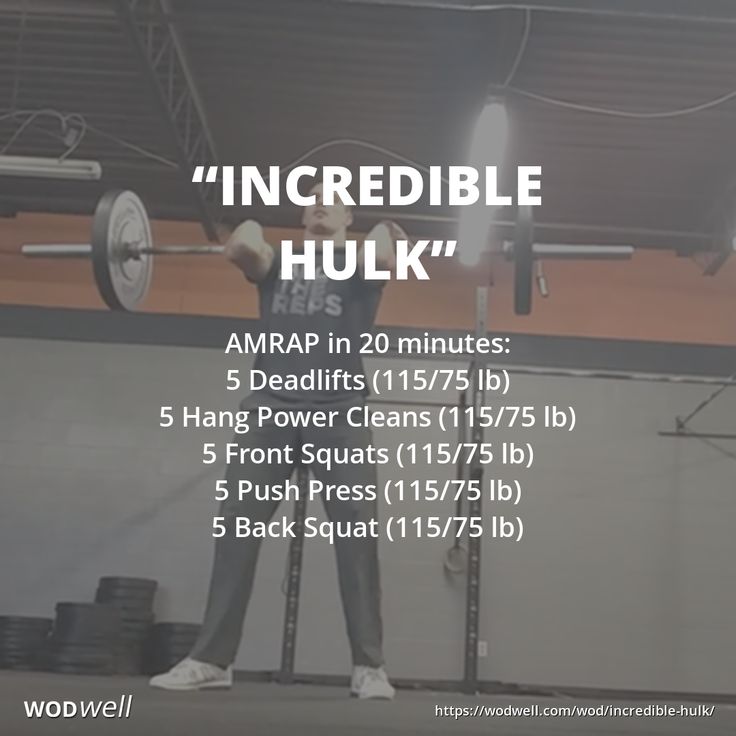 Взятие на грудь в висе отличается от взятия на грудь, взятия на грудь или взятия на грудь, хотя все они невероятно похожи.
Взятие на грудь в висе отличается от взятия на грудь, взятия на грудь или взятия на грудь, хотя все они невероятно похожи.
Посмотрите видео ниже, чтобы узнать разницу между каждым упражнением, и вы сможете перевести это на другие типы подъема.
Теперь, когда вы знаете, что от вас ожидается при зависании, научитесь делать это правильно.
Как выполнять толчок в висе
Как вы могли видеть на видео выше, толчок в висе означает, что штанга не будет касаться пола, и спортсмену не потребуется выполнять полный присед после подъема вес.
- Приготовьте штангу с нужным весом.
- Возьмитесь за гриф крюком
- Встаньте прямо, прижав штангу к бедрам. Это исходное положение.

- В начале движения вы медленно опускаете штангу ниже линии колен, слегка сгибая ноги.
- Во взрывном движении упритесь ногами в пол, агрессивно вытяните бедра и ноги и держите штангу близко к телу.
- Пожав плечами, завершите подъемное движение со штангой в положении передней стойки.
- После этого полностью выпрямите ноги, выполнив частичный присед.
- Это один представитель.
Работающие мышцы
Подъем на грудь в висе задействует в первую очередь среднюю часть тела, а также верхнюю часть тела и ноги, в меньшей степени.
- Ягодичные мышцы
- Нижняя часть спины
- Приводящие мышцы
- Подколенные сухожилия
- Трапециевидные мышцы
- Сгибатели предплечья
Это также повысит вашу силу хвата .
Ошибки, которых следует избегать
1. Штанга не соприкасается с телом
Если ваши плечи ужасно болят после силового взятия на грудь в висе, вероятно, штанга поднимается не прямо вверх при подъеме, а скорее по изгибу от вашего тела во время движения. В этом случае вес приземлится на ваши плечи с ударом, а не просто небрежно ляжет на ваше тело.
Чтобы исправить это, убедитесь, что вы не опускаете штангу слишком сильно в начале движения, что может вынудить вас выдвинуть бедра вперед, в результате чего штанга будет подниматься вверх от вашего тела.
2. Не использовать ноги для подъема штанги
Подобно предыдущей проблеме, эта проблема связана с тем, что при подъеме штанги слишком сильно используются бедра.
Если вы слишком сильно задействуете бедра, штанга уйдет от тела, и вы будете использовать бедра гораздо больше, чем нужно, чтобы начать движение.
3. Прием штанги без поднятия локтей
В конце движения, при приеме штанги в передней стойке, вы должны отводить локти в стороны и высоко.
В противном случае ваши запястья будут подвергаться дополнительной нагрузке, что может привести к травмам.
Преимущества уборки с усилием в висе
Уборка с усилием в висе представляет собой более простую версию взятия на грудь и уборку с усилием.
Таким образом, подъем на грудь в висе отлично подходит для начинающих, которым необходимо изучить основы движения . Это устраняет необходимость делать полный присед или поднимать вес с пола, что может побудить новичков начать олимпийскую тяжелую атлетику.
Источник: Дэн Бейли
Для более продвинутых спортсменов, взятие на грудь в висе может помочь вам улучшить технику взятия на грудь , так что вы узнаете и почувствуете, где находится правильная точка контакта при выполнении толчка на грудь.
Из-за укороченного диапазона движений силовой толчок в висе увеличит вашу взрывную силу , ваша способность быстрее развивать силу и мощь.
Некоторые другие спортсмены также имеют проблемы с подвижностью (особенно очень высокие спортсмены), поэтому подъем на грудь в висе является отличной заменой для тех, кто все еще хочет работать с этими мышцами.
Вариации силового взятия на грудь в висе
Как и ожидалось, есть два варианта силового взятия на грудь в висе, о которых упоминалось ранее: взятие на грудь, силовое взятие на грудь и взятие на грудь в висе.
Power Clean начинается со штангой на полу. Спортсмен поднимает штангу по той же схеме движения и ставит штангу на переднюю стойку перед тем, как полностью разогнуть бедра и ноги. В этом движении по-прежнему используется частичный присед.
Ознакомьтесь с нашим руководством по идеальной уборке.
Подтягивание в висе начинается со штанги на бедрах, как обычно при подтягивании в висе. Основное отличие состоит в том, что после выталкивания штанги в положение передней стойки спортсмен должен выполнить полный глубокий присед и только потом разгибать бедра и ноги.
В тренажере Clean используется тот же диапазон олимпийских подъемных движений, но штанга начинается с пола. Спортсмен также должен выполнять полный присед вместо частичного, прежде чем разгибать бедра и ноги. Это упражнение на полную амплитуду по сравнению с силовым взятием на грудь и силовым взятием на грудь в висе.
Подробнее: 15 чистых тренировок для развития взрывной силы и улучшения навыков поднятия тяжестей.
Расширьте свои знания
Улучшите свой олимпийский подъем, освоив Толчок , Power Clean , Подтягивание в висе и Толчок 0 .
Источники изображений
- dan-b: Dan Bailey
- clean: Stevie D Photography
Последние статьи
Новости по теме
Подъем на грудь в висе — Техника для кроссфита
Подъем на грудь в висе является разновидностью подъема на грудь и подъема на грудь.
В олимпийской тяжелой атлетике подъем на грудь обычно включается в качестве вспомогательного движения для одного из основных упражнений — толчка.
В кроссфите подъем на грудь в висе встречается в нескольких местах, обычно он запрограммирован во время силовой тренировки или встроен в меткон.
Это также хороший способ научить спортсменов резко разгибать бедра, что является ключевым для многих других движений в кроссфите (примеры: рывок и толчок на грудь , и это лишь некоторые из них)
Самое главное чтобы убедиться, что у вас есть хороший крюк захват на руле.
- Ноги на ширине плеч
- Руки сразу за коленями (чистый хват)
- Груз на пятках
- Груз на пятках — даже когда вы наклоняетесь вперед до колена, держите вес на пятках. Вам нужно будет проехать через них, чтобы создать максимальную силу.
- Взрывные бедра — ключ к перемещению большого веса (и правильному выполнению) — вытягивать бедра вперед во время подтягивания.
- Положение захвата – ваши локти должны быть в вертикальном положении, а гриф должен опираться на ключицу.
 Если у вас проблемы с мобильностью передней стойки , это положение может быть трудным.
Если у вас проблемы с мобильностью передней стойки , это положение может быть трудным. - Задействована спина – особенно при выполнении повторений вместе, следите за тем, чтобы ваша спина никогда не «выгибалась» в какой-либо точке. Хорошее вовлечение позвоночника и сигнал «гордая грудь» будут удерживать вас в правильном положении.
У некоторых людей самая слабая позиция — это тяга от пола, поэтому взятие на грудь в висе может фактически позволить вам поднять на больше веса над головой .
Используйте это руководство, чтобы освоить технику или узнать больше о толкающем рывке .
- Улучшение техники очистки – оттачивая вторую фазу подтягивания и ловли, вы можете отточить или улучшить технику на этих фазах взятия на полную мощность.



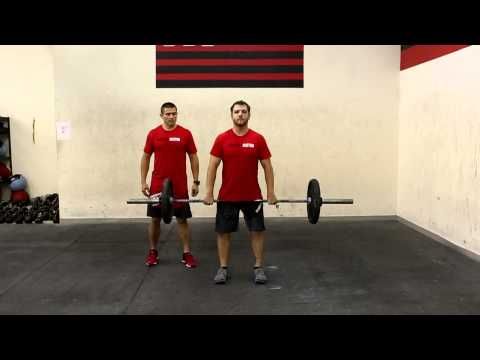


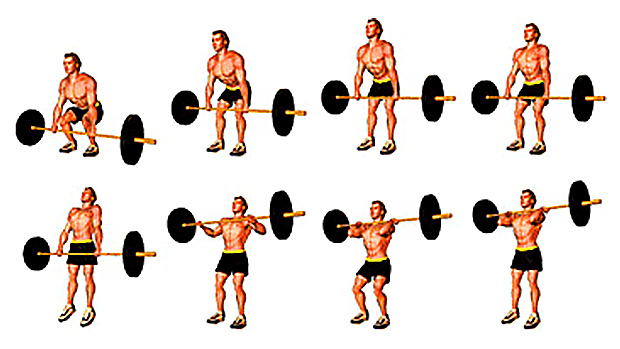
 Если у вас проблемы с мобильностью передней стойки , это положение может быть трудным.
Если у вас проблемы с мобильностью передней стойки , это положение может быть трудным.